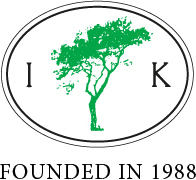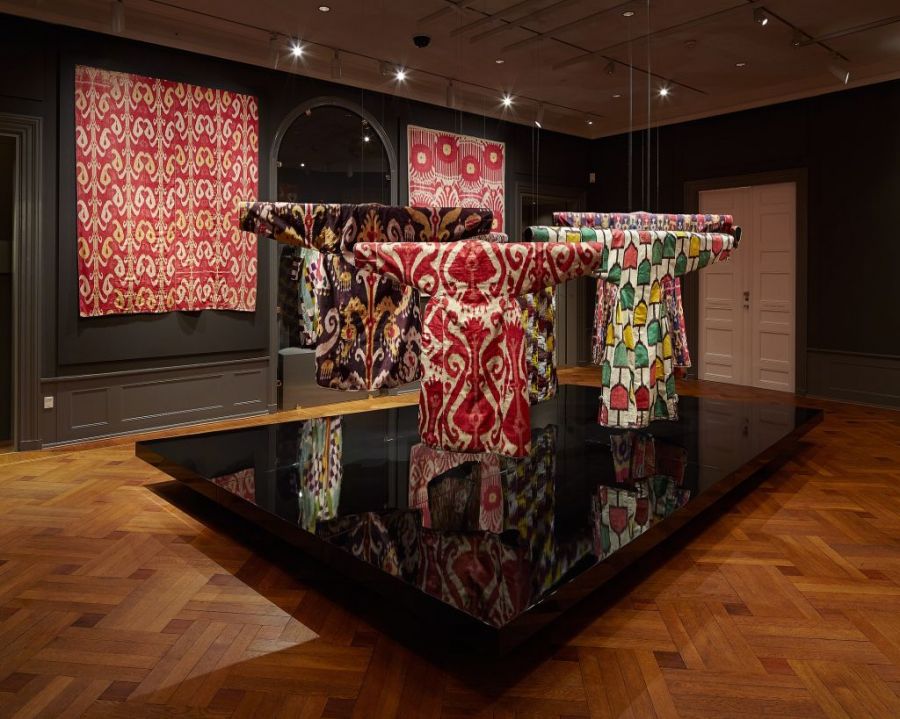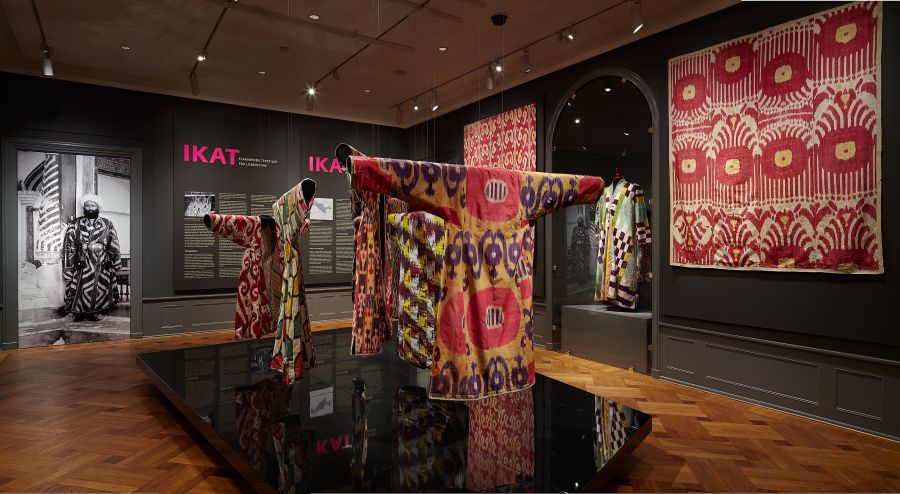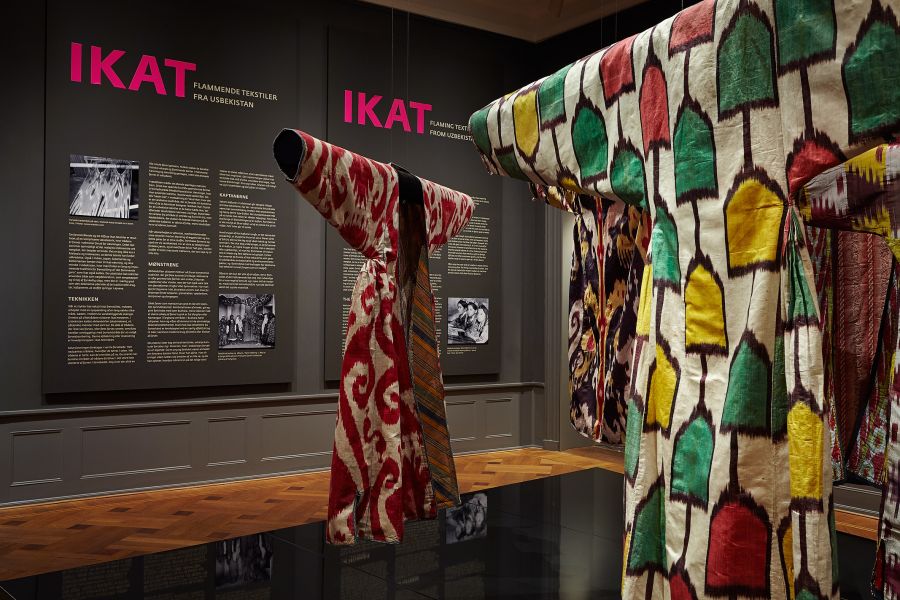ikfoundation.org
Promoting Natural & Cultural History



ESSAYS |
IKAT
Exhibition displaying Textiles from Uzbekistan
On a September day in 2012, I visited Davids Samling (the David Collection) in København, Denmark – to view a most interesting exhibition. The visit gave me both an opportunity for my observations and an informative guided tour in Danish by Anne-Marie Keblow Bernsted, who has specialised knowledge of the ikat fabrics’ history, materials and dyeing traditions. The aim of this essay is, therefore, to share some pieces of information about the complex ikat-dyed fabrics from Uzbekistan together with the museum’s magnificent photographs from the exhibition.
 Courtesy of: The David Collection, The Exhibition: Ikat – Flaming Textiles from Uzbekistan (2012-2013).
Courtesy of: The David Collection, The Exhibition: Ikat – Flaming Textiles from Uzbekistan (2012-2013).Ikat dyeing and weaving with the finest of silk thread have traditions continuing far back in time in Uzbekistan, among other places from the regions of Bukhara and Samarkand. One of the Silk Road’s trade routes also stretches across these areas, where one of the world's oldest preserved ikat fabrics (10th century) has its origin. However, the kaftans, trousers and other ikat woven fabrics – used by both men and women – displayed in this exhibition were principally made in the 19th- up to the early 20th century.
Anne-Marie Keblow Bernsted explained that 12.000 weavers worked in the area during this period. The advanced combination of reeling silk, ikat dyeing and weaving started with a silk worm’s cocoon which during the reeling gave 1.000 metres of the finest silk thread, and every kaftan needed approximately 20.000 metres of thread or 20 cocoons. These facts indicate that the fabrics are of an incomprehensible fine quality, making it preferable to use 4 or 5 kaftans on top of each other to keep warm. Still, warmth was not the only reason for using an excessive number of garments; it was additionally a status symbol for owning and using several of these costly kaftans.
 Courtesy of: The David Collection, The Exhibition: Ikat – Flaming Textiles from Uzbekistan (2012-2013).
Courtesy of: The David Collection, The Exhibition: Ikat – Flaming Textiles from Uzbekistan (2012-2013).Patterns vary mainly from district to district and are designed with simple geometrical shapes or more complex compositions like flower motifs, Paisley, “flaming” variations, trees of life and often with mirror effects of the said patterns. The technique used is a high-density ribbed weave, where the one-coloured weft is completely covered by the ikat-dyed warp. The ikat technique/design is, in other words, always dyed on the warp threads before the weaving process. The extremely dense weave has 10 threads per millimetre or ca. 4.000 threads on a weave width of 40 cm!
The dominating colours of the fabrics are red, yellow, mauve, blue, black and white. Red was mostly dyed with madder, but cochineal was also in use. Indigo for blue, oak for black and sumac for yellow shades, together with several other local plants dyeing yellow. Natural dyeing of these extremely fine silks was even so complex that each colour had its own dyer. A close-up study of the fabrics also reveals that faintly white stripes sometimes appear on the ikat dyed patterns; this kind of imperfection could happen when the tying of the warp has not been as “precise” as the dyer had wished. Finishing the fabrics with a mixture of egg white also made the colours more profound, intense and durable.
 Courtesy of: The David Collection, The Exhibition: Ikat – Flaming Textiles from Uzbekistan (2012-2013).
Courtesy of: The David Collection, The Exhibition: Ikat – Flaming Textiles from Uzbekistan (2012-2013).There is some uncertainty at what time in history these beautiful textiles were introduced to/developed in Uzbekistan, but it can be established that the fabrics are most complex in choice of material, density of quality, dyeing design, as well as the overall weaving craftsmanship. The weaving in itself is of a relatively uncomplicated ribbed weave, but the fineness and numbers of the threads add to its complexity. The kaftan’s wide design also makes it necessary to use several widths of the narrow fabric (only 30 to 50 cm width). An interesting detail is also the tablet woven cotton ribbons, which have been sewn along the edges of some kaftans displayed in the exhibition. These ribbons were probably both considered as a decorative element as well as a strengthening of the garments. The same purposes had the printed cotton used as linings, a type of fabric imported via the Silk Route from Russia.
Source:
- Visit “Ikat – flaming textiles from Uzbekistan”, displaying a selection of ikat-dyed textiles from the David Collection in København, Denmark, on a guided tour by Anne-Marie Keblow Bernsted. The exhibition took place: April 21, 2012 – February 24, 2013. No book or catalogue assisted the exhibition.
Essays
The iTEXTILIS is a division of The IK Workshop Society - a global and unique forum for all those interested in Natural & Cultural History from a Textile Perspective.
Open Access essays - under a Creative Commons license and free for everyone to read - by Textile historian Viveka Hansen aiming to combine her current research and printed monographs with previous projects dating back to the late 1980s. Some essays also include unique archive material originally published in other languages, made available for the first time in English, opening up historical studies previously little known outside the north European countries. Together with other branches of her work; considering textile trade, material culture, cloth manufacturing, fashion, natural dyeing and the fascinating world of early travelling naturalists – like the "Linnaean network" – from a Global history perspective.
For regular updates, and to make full use of iTEXTILIS' possibilities, we recommend fellowship by subscribing to our monthly newsletter iMESSENGER.
been copied to your clipboard




– a truly European organisation since 1988
Legal issues | Forget me | and much more...
It is free to use the information/knowledge in The IK Workshop Society so long as you follow a few rules.
 LEARN MORE
LEARN MORE








